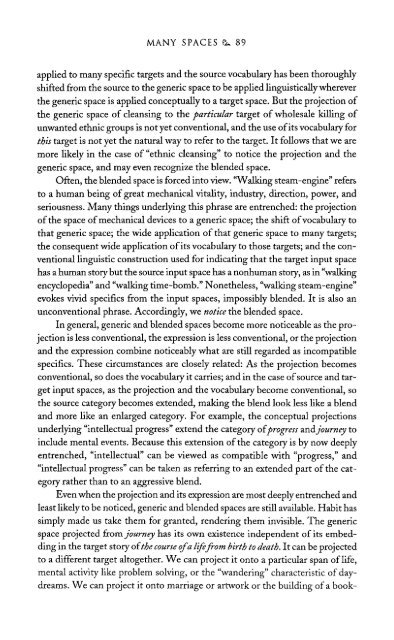The Literary Mind.pdf
The Literary Mind.pdf
The Literary Mind.pdf
You also want an ePaper? Increase the reach of your titles
YUMPU automatically turns print PDFs into web optimized ePapers that Google loves.
MANY SPACES 89<br />
applied to many specific targets and the source vocabulary has been thoroughly<br />
shifted from the source to the generic space to be applied linguistically wherever<br />
the generic space is applied conceptually to a target space. But the projection of<br />
the generic space of cleansing to the particular target of wholesale killing of<br />
unwanted ethnic groups is not yet conventional, and the use of its vocabulary for<br />
this target is not yet the natural way to refer to the target. It follows that we are<br />
more likely in the case of "ethnic cleansing" to notice the projection and the<br />
generic space, and may even recognize the blended space.<br />
Often, the blended space is forced into view. "Walking steam-engine" refers<br />
to a human being of great mechanical vitality, industry, direction, power, and<br />
seriousness. Many things underlying this phrase are entrenched: the projection<br />
of the space of mechanical devices to a generic space; the shift of vocabulary to<br />
that generic space; the wide application of that generic space to many targets;<br />
the consequent wide application of its vocabulary to those targets; and the conventional<br />
linguistic construction used for indicating that the target input space<br />
has a human story but the source input space has a nonhuman story, as in "walking<br />
encyclopedia" and "walking time-bomb." Nonetheless, "walking steam-engine"<br />
evokes vivid specifics from the input spaces, impossibly blended. It is also an<br />
unconventional phrase. Accordingly, we notice the blended space.<br />
In general, generic and blended spaces become more noticeable as the projection<br />
is less conventional, the expression is less conventional, or the projection<br />
and the expression combine noticeably what are still regarded as incompatible<br />
specifics. <strong>The</strong>se circumstances are closely related: As the projection becomes<br />
conventional, so does the vocabulary it carries; and in the case of source and target<br />
input spaces, as the projection and the vocabulary become conventional, so<br />
the source category becomes extended, making the blend look less like a blend<br />
and more like an enlarged category. For example, the conceptual projections<br />
underlying "intellectual progress" extend the category of progress and journey to<br />
include mental events. Because this extension of the category is by now deeply<br />
entrenched, "intellectual" can be viewed as compatible with "progress," and<br />
"intellectual progress" can be taken as referring to an extended part of the category<br />
rather than to an aggressive blend.<br />
Even when the projection and its expression are most deeply entrenched and<br />
least likely to be noticed, generic and blended spaces are still available. Habit has<br />
simply made us take them for granted, rendering them invisible. <strong>The</strong> generic<br />
space projected from journey has its own existence independent of its embedding<br />
in the target story of the course of a life from birth to death. It can be projected<br />
to a different target altogether. We can project it onto a particular span of life,<br />
mental activity like problem solving, or the "wandering" characteristic of daydreams.<br />
We can project it onto marriage or artwork or the building of a book-















